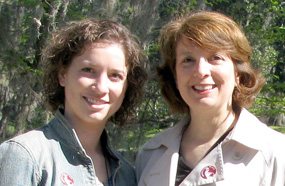

|
|
Empty Nest Magazine
|
TRAVEL
Charleston, SC: Mother-Daughter Rendezvous by Emilie and Gretchen Haertsch
It was a late Saturday afternoon in mid-March 2009, and we were happily exhausted after touring a museum, two historic house museums, and nine glorious private homes and gardens in Charleston, South Carolina. It was only Day Two of our long weekend in the history-filled city, yet our mother-daughter bonding had already kicked in on the long car ride from Raleigh, North Carolina, the previous day. Our real lives were slipping away: one as an adjunct professor at a Philadelphia-area college, the other as a recent college grad doing an unpaid year of service in Raleigh. Toss in relentless elder care for the mother and near-poverty living conditions for the daughter, and the importance of the trip becomes clear. Plus, in our forced separation, we missed each other! And Charleston would not disappoint. For mothers and adult daughters, Charleston during its annual Festival of Houses and Gardens is the perfect spring getaway—especially for history and gardening buffs, but it’s not a bad bet for shoppers or foodies either.
Gardens and Antiques
A wise first stop early Friday afternoon was the downtown Visitor’s Center on Meeting Street, where we purchased our garden tour passes. Close to the Visitor’s Center is the Aiken-Rhett House—a fitting introduction to antebellum life. Built in 1818, the house stayed in the same family until the 1970s, and it has been virtually unaltered since 1858. Its crumbling wallpaper and original furnishings add to the evocative feel of the home’s double parlors, ballroom, art gallery, and abundant bedrooms, whereas the slave quarters illustrate another side of Charleston’s less glamorous history. The Heritage Passport allows visits to tour three more historic homes, the Gibbes Museum of Art, the Charleston Museum, and two plantations outside Charleston. We were surprised to learn the Charleston Museum is the oldest museum in the country. It’s a good place to start your tour, because it provides an overview of the rice plantation system, built on the backs of West African slave skill and labor, and the basis for Charleston’s decadent wealth. The garden tour, in our case in the Legare Street area, provides a nice contrast to the museum feel of the historic houses. The homes on the tour are old, yet, unlike the museums, they’re actually lived in. From transformed outbuildings to cobbled courtyards and pool areas, all vibrant with foliage and blooms, it was a special mother-daughter pleasure to envision how the other half lives and gardens. And for the warmth-starved Northerner, the tour was also a pleasant spring tonic.
Lowcountry Dining We also recommend the three-course prix fixe menu at Middleton Place, a plantation just outside the city. The extensive gardens, easily visible from the restaurant’s large windows, are idyllic, and the fare sophisticated. Diners choose a first course of soup or salad, among them the famous Lowcountry she-crab soup. Southern entrée options include shrimp and grits, catfish, gumbo, and quail. There is a fine selection of desserts, some regional and some classic. This mother-daughter team feasted on the Lowcountry Sampler of West African peanut soup, pork barbecue, hoppin’ John, okra and tomatoes, collard greens, and biscuits. Neither could resist the Huguenot torte. For our trip’s “fancy dinner,” we ventured no further than the historic 82 Queen, next door to our inn. Though dining in the courtyard, splendid with twinkling lights, was possible, the cool evening snap chased us indoors, where we found the setting candle-filled and quiet, the service exceptional. The duck was tender and succulent, the Jamaican jerk chicken spicy and satisfying. We lingered over our food, discussing our day’s experiences. Clearly, eating in Charleston was an event.
The Plantation System From Middleton Place it was only a short drive to Drayton Hall, the oldest preserved plantation house in America open to the public (1738). Our tour guide—Jill—wore a cloak and had a flare for the dramatic. She transformed the stunning unfurnished house with her words, transporting us back to its heyday. After the tour, we explored the marsh paths on foot before returning to Charleston in the dusk.
Fond Farewells
 Gretchen Haertsch teaches writing at Arcadia University, near Philadelphia. Daughter Emilie just completed a year of service in North Carolina and is currently working for the Pennsylvania Humanities Council in Philadelphia. She is also a graduate student in creative nonfiction at Goucher College (MD). This is the first time the Haertsches have shared their mother-daughter adventures with Empty Nest. Gretchen Haertsch teaches writing at Arcadia University, near Philadelphia. Daughter Emilie just completed a year of service in North Carolina and is currently working for the Pennsylvania Humanities Council in Philadelphia. She is also a graduate student in creative nonfiction at Goucher College (MD). This is the first time the Haertsches have shared their mother-daughter adventures with Empty Nest. |
Empty Nest: A Magazine for Mature Families
© 2010 Spring Mount Communications